Metroid Prime 3: Quarterly Diaries #10
November 6th, 2009

Areas Covered: Landing Site Alpha
Discussion Points: Transition from stealth to mild combat, Scrapvault room, Metroid Processing room, Gandrayda battle, Transit Station
Landing Site Alpha (Research Facility)
The Pirate Homeworld begins very quietly and then slowly becomes more action intensive as the player mines further into the pirate’s base. As we know from last time the first sequence of gameplay, Landing Site Bravo, was primarily a stealth section and only contained a few short lapses of combat. Only a handful of space pirates populate the facility, so rather than facilitate another stealth sequence, the mood is simply quiet. Combat is still fairly lite, yet if the player trips any of the security lasers, reinforcements come rolling in. The lasers become visible with the X-ray visor, so I guess the area is designed as a tutorial, but considering you most likely won’t even flick to the visor and just step right on though (like me!) it’s not very effective. Metroids too populate the area, but they don’t elevate the mood in the same way the pirates do. (Pirate confrontations always feel like a big deal with the intrusive crescendo of the dissonant pirate’s theme, and in the case of the homeworld, the alarm system which blurs red into the already bloodshot environment).
This area, besides junction at the Metroid Processing room, is linear so I’m just going to talk about the individual rooms for this post.
The first major room of this area, Scrapvault, feels rather jarring due to the floors of architecture piled on top of each other. The centre of this room is insufficient in size, strangled and quartered off by the walkway into the environment and the levels of platforms looming over the space. It’s a room which emphasises the constricting nature of the homeworld. Space pirates will later trap you into this area, taking advantage of the room’s layout to bind you in the one spot. The ensuing battle therefore has a good deal of tension as the pirates can easily get in your face. As with the visual presentation of this area, the layout of the environments present themselves as malformed and thereby ugly and uncomfortable to play in.The pieces, both visual and architectural very much work in unison to instill a sense of confinement onto the player.
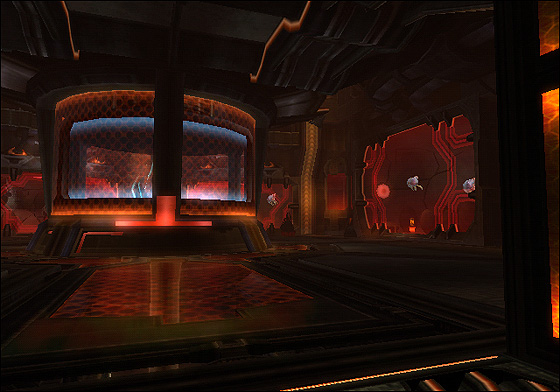
The next major room, Metroid Processing, a circular room housing several caged Metroids, puts the player in a similar predicament to that of the Metroid labs on Elysia. The player is forced to remove another energy cell and hence free the caged Metroids on themselves. The environmental artist who designed this room posted some commentaries on Conceptart.org, here’s what he had to say:
“This room was a lot of fun too. I always considered the Metroids themselves to be one of the most interesting aspects of the series, and easily one of the most original creatures in gaming. I wanted this room to feel something like a Metroid museum of sorts. I thought about the ways the pirates would test and analyze the Metroids, and different experiments they would put them through. Like the statuary room in Bryyo, I wrote many notes to correspond with some of the different things I put into the room. Many of these made it into the game actually, although they had to be edited due to text size restrictions. I made the Metroid eggs specific for this room. I watched the intro to Super Metroid again, and noticed that the fluid inside the egg dries almost instantly when exposed to the air. I created some “hatched” eggs similar to this, with the embryonic fluids hardened immediately in their dripping state. I’ll include the notes I made as well, for those interested in the fiction I created personally for the room.
When I first started working on this room, I envisioned all different types of Metroids being housed here, as if this was the main research facility where all different variations of the creature were brought and studied. Due to a number of reasons, many of these variations did not make it into the final game, but some of the write-ups mention them.”
The room acts as a junction, but acid rain cuts off complete access to the room on the right-hand side, so we’ll come back to that on our revisiting of this environment. The room on the left will take us to the federation marine who sent out the distress signal.
Samus finds the marine stranded, pinned down by space pirates. After clearing away the pirate vermin, the duo work together to activate the elevator when the marine transforms into Gandrayda that mighty-morphing bounty hunter dead jealous of Samus, she’s corrupted just like the other bounty hunters; a battle ensues.
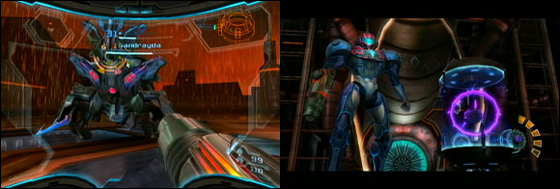
Gandrayda uses her shape-shifting abilities to morph herself into a series of familiar enemies and bosses. In this regard the battle is a mash-up of previous confrontations. In her normal and Samus states Gandrayda’s movement patterns are akin Dark Samus’ in the duel at the end of Metroid Prime 2. Can’t remember? What I mean is she glides around the environment just quick enough to make her a bothersome target. Particularly as the battle nears its close, she can become just flat out annoying.
The premise leading into the battle, where Gandrayda takes the form of a marine and proceeds to trick Samus, was a cool, justly executed premise, I thought.
The spoils of victory for this round is the Grapple Voltage, another take on the grapple beam which drains and charges various shield generators. It’s very much another bit-part upgrade, but useful nonetheless.
If you follow the trail along you come to a transit station with a giant cargo train which Samus can ride all the way back to the start of this area. I quite liked the trains as they look very industrious and link the environments well together. The train sends you right around to a room just nearby to where we landed the ship.
Additional Readings
Food For Thought: Metroid Prime 2 And Other M – Siliconera
Metroid Prime 3: Quarterly Diaries #9
October 28th, 2009

Areas Covered: Landing Site Bravo
Discussion Points: Visual design of the Pirate Homeworld, space pirate lore scans, looping environments in the Metroid series, the use of acid rain, x-ray visor
Landing Site Bravo (Pirate Homeworld)
Considering the Space Pirates’ feverish hate for federation bounty hunters named Samus Aran, it’s bewildering that they’d simply allow her to steer her ship right on through to their command and research centres without any kind of safeguard or inspection. In any case, we’re here now, let’s make the most of it!
Visually, the Pirate Homeworld shares the same dark, ominous tone of GFS Valhalla, the key exception being that the landscape is draped in a confronting, bloodshot red fog. Perhaps it’s over saturated, but, as with the Dark World in Metroid Prime 2, it seems uncharacteristically dark by intentionally drawing together design elements which clash and overpower one another. It’s ugly enough to instill repulsion without the game appearing artistically flawed. The red is very overpowering, working with the enclosed architecture to almost suffocate the player.
The pirate lore scans in this area, as has been the case with the other pirate entries from the previous two games, are absolutely fascinating to read as they throw light on the fringe operations of the rogue group in a way characterized by the pirates themselves. The lore scans here also serve to fill in the blanks on the pirate’s exploits since Metroid Prime 2, including their recent allegiance with Dark Samus. The scans, written from the perspective of the pirates, depict Dark Samus as something of a messiah, who through uniting the race with phazon, has finally given the pirates strength in the ongoing battle against the Galactic Federation. I know the space pirates are an over-zealous bunch—the previous games have said this much—but they seem of either complete desperation or completely warped by the involvement of Dark Samus. Maybe it’s got something to do with her influence over the processing of phazon. I’m curious to see how this whole saga ends.
The Metroid games always operate in a hub environment with an overworld connecting to a series of smaller areas. Each of these individual areas are designed so that the player ends up looping around, returning to their point of entry (or similar) in the overworld. This looping dynamic is either designed in a linear fashion, wherein the environment itself loops around or by relying on backtracking which—on the reverse path—rejigs the route so that the latest weapon upgrades can be utilized, thereby making the retread enjoyable. That’s not to say that the former doesn’t also tutor the newly-acquired weapon upgrades, it does, but it’s just progressional with the linear path, rather than relying on a rejigged environment etc. We’ve discussed both design techniques and their application numerous times before in this series, I just hadn’t really put it forward so discreetly yet. So in saying this, the Landing Site Bravo area relies on a linear route which loops through at the gate of the first floor elevator. It also ties in nicely with the map station which is concealed from players when they first make entry into the environment.
When you arrive to the Command Courtyard there’s a cutscene which shows a pirate entering the main section of the facility, the cutscene also highlights two upgrades which you’ll acquire in this area, being the hazard shield (the glow around his body) and the Grapple Voltage (the gate’s force field).
As a choice of environmental design, I’d probably criticize the acid rain plaguing the homeworld as being a little too cliché of dystopic environments, but functionally it’s quite clever. The acid rain throughout the Pirate Homeworld works as a tool to segregate the environment based on whether or not you have the hazard suit upgrade. The acid rain also has a multitude of other functions, here’s a list of what I came up with:
1 ) Heavy rain is a trope of dystopic environments, so it feels well suited to characterize the epicentre of the pirate’s operations
2 ) The rain doesn’t feel as though it restricts access to other areas of the homeworld, even though that’s its ultimate function. When the player walks out into the rain their suit receives damage, but they are still, seemingly, free to explore these areas despite the fact that the rations of energy tanks given at this point don’t allow you to make any real leeway
3 ) It divides the environment into (safe) interior and (hazardous) exterior components where Samus initially can only explore in sheltered areas…
4 ) …by which case Retro use the initial sequence as an infiltration sequence where the pirates are out in the open and Samus is snooping around behind glass
5 )They also use the divide as a tool for seamless narrative, so while Samus is infiltrating from behind the scenes, she can witness the stage in which the pirates are scheming whatever it is they’re scheming
6 ) By using the rain to facilitate the infiltration sequence, it legitimizes the little combat at the beginning of this area and then afterwards, as Samus obtains upgrades and further mines the complex, it legitimizes the increase in action and thereby difficulty. The presentation is one of common sense.
7 ) The rain quite obviously necessitates the usefulness of the hazard shield upgrade
8 ) If you look up at the drain it splashes black droplets, that’s neat!
After some snooping about Samus, for the second time in the series, discovers the X-ray visor. I must say, the perspective certainly looks a lot prettier than in the original Metroid Prime. I will admit that seeing the bones in her arms is a little creepy. It’s initial application on the codified key pad didn’t really leave me impressed. However, after some time with the visor, I’ve come to realize that overall the key pad mechanic is just a small addition to the application set which the visor can be used for, so it just seems a little underwhelming from the onset for returning players. Furthermore, they mix up the application a little later in the game.
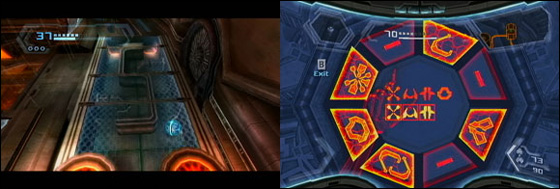
At the end of the stage the player receives a distress call from a marine stationed in the next area, the pirate’s research facility. Time to investigate!
Additional Readings
Design Differences: Metroid Prime 1 and Prime 3
Metroid Prime 3: Quarterly Diaries #8
October 26th, 2009

Areas Covered: Sky Town Spire, Elysia Seed
Discussion Points: Bombing of the Elysia Seed, Helios boss battle
Sky Town Spire
With all of the pieces in place the formal precedings can begin. I never actually clicked previously to what was about to happen here, so when the Aurora Unit explained it to me in plain English, I must confess, I thought it was little convoluted. Let me explain what happens and you can decide for yourself: basically, with all the components assembled the bomb is now primed for launch. Using her ship as a hoist Samus drops the assembled bomb onto the centre-most point of Sky Town. The Aurora Unit then moves Sky Town (yes, the entire network of islands) closer towards the seed and disconnects the centre from the rest of the structure allowing it to free-fall towards the seed. The goal is for the structure to hit shield so that the bomb can explode and power down the force field thereby granting Samus access to the seed. Samus must stay on the structure as it’s falling to prevent any incoming space pirates from diverting the course. Once the bomb is in close proximity Samus can evacuate in an escape pod. The structure hits the shield and the bomb explodes.
This highly scripted premise—which in terms of playable bits consists of defending this free-falling structure armed with explosives only to narrowly escape—seems like something decidedly ripped from an action movie—therefore to a certain extent feels un-Metroid-like. Furthermore it’s questionable whether this set piece was worth the hassle of setting up. Both of these are fair points of criticism and, as with the initial encounter with Ridley, the action feels contrived and forced. That isn’t to take away from the experience, it works quite well and it’s nice to see new ideas applied to the Metroid formula, but it also feels like the creative spark is starting to wear thin.
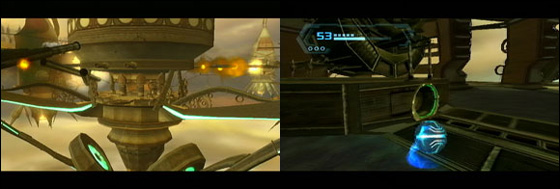
The crux of this sequence is a tough shootout followed by a tense escape. The shootout is probably the trickiest so far as several ships surround the circular playing field at the one time and pirates are dispatched from them at every side. The danger comes in thick and fast which’ll have you reliant on hyper mode. Once you’ve dispatched enough pirates, you’re clear to activate your escape pod but—OH NO!—the pod is faulty. A small morphball hatch opens for you to frantically head downstairs to mend the device with a series of plasma welding mini games as a timer begins countdown. The setback is predictable but works well, you can see what I mean what I say it’s contrived though.
One final point I wish to make is that this sequence actually made me wishing that the Wii was a little more technically able, simply because the illusion of falling would have been much more effective with something more attractive an ugly brown haze. In fact, the actual illusion wasn’t too convincing and could have benefited from the structure bumping around a little. Also, what’s with the gravity? How is Samus not ripped to the top of the ceiling as soon as the structure begins to free-fall?
Elysia Seed
In the Elysia seed you take on Helios, a creature made of flying bats which can shift into two shapes: A ball which haphazardly rolls around the arena or a Gunstar-Heroes-esque humanoid who chases you in circles.After blasting off the outer layer of bats, the creature will float in air with 5 red dots revealing themselves around its outer centre at which point you can attack Helios with your seeker missiles to reduce him to his next form. Once you’ve done this you can start dishing our proper damage and eventually whittle him down to nothing.
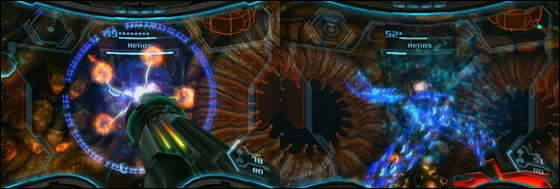
The battle comprises of a tonn of blasting, stopgapped by a brief moment for the mandatory use of the latest weapon upgrade and then some more blasting. It’s in this regard that the battle feels rather unfulfilling, the meat of it isn’t entirely engaging. Well, that’s partly a lie. Helios has some clever movement patterns mixing up the confrontation so that it doesn’t feel like spam from the blaster. Afterwards you’re rewarded with the hyper missiles and hence we see a trend emerging.
Additional Reading
An Explanation For Metroid Prime 3’s Pointless “Hyper Mode” – Siliconera



 Game Design Companion: A Critical Analysis of Wario Land 4 - $7.99
Game Design Companion: A Critical Analysis of Wario Land 4 - $7.99 Level Design: Processes and Experiences
Level Design: Processes and Experiences Speed Boost: The Hidden Secrets Behind Arcade Racing Design - $5.99
Speed Boost: The Hidden Secrets Behind Arcade Racing Design - $5.99 Adventures in Games Analysis: Volume I - $5.99
Adventures in Games Analysis: Volume I - $5.99







